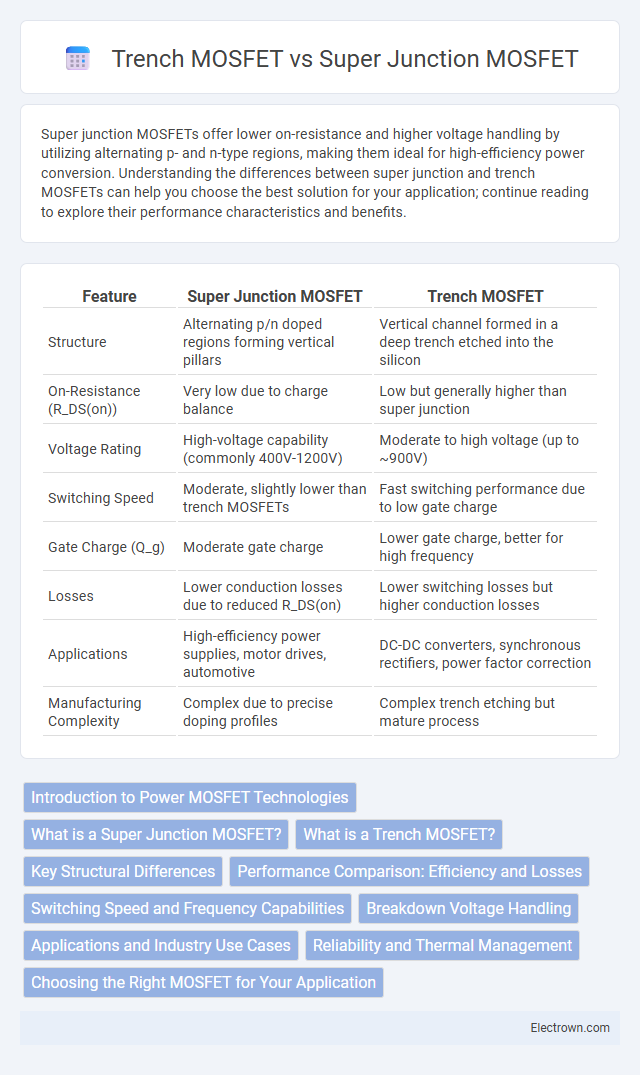Super junction MOSFETs offer lower on-resistance and higher voltage handling by utilizing alternating p- and n-type regions, making them ideal for high-efficiency power conversion. Understanding the differences between super junction and trench MOSFETs can help you choose the best solution for your application; continue reading to explore their performance characteristics and benefits.
Table of Comparison
| Feature | Super Junction MOSFET | Trench MOSFET |
|---|---|---|
| Structure | Alternating p/n doped regions forming vertical pillars | Vertical channel formed in a deep trench etched into the silicon |
| On-Resistance (R_DS(on)) | Very low due to charge balance | Low but generally higher than super junction |
| Voltage Rating | High-voltage capability (commonly 400V-1200V) | Moderate to high voltage (up to ~900V) |
| Switching Speed | Moderate, slightly lower than trench MOSFETs | Fast switching performance due to low gate charge |
| Gate Charge (Q_g) | Moderate gate charge | Lower gate charge, better for high frequency |
| Losses | Lower conduction losses due to reduced R_DS(on) | Lower switching losses but higher conduction losses |
| Applications | High-efficiency power supplies, motor drives, automotive | DC-DC converters, synchronous rectifiers, power factor correction |
| Manufacturing Complexity | Complex due to precise doping profiles | Complex trench etching but mature process |
Introduction to Power MOSFET Technologies
Super junction MOSFETs utilize alternating p- and n-type regions to significantly reduce on-resistance and improve efficiency in high-voltage applications, whereas trench MOSFETs employ vertical gate structures to enhance current density and switching speed. Power MOSFET technologies focus on optimizing conduction and switching characteristics to meet the demands of modern power electronics, with super junction devices excelling in high-voltage scenarios and trench MOSFETs offering advantages in low-voltage, high-frequency circuits. The choice between these technologies depends on application-specific requirements such as voltage rating, efficiency, and thermal performance.
What is a Super Junction MOSFET?
A Super Junction MOSFET is a power transistor designed with alternating p-type and n-type layers within the drift region, significantly reducing on-resistance while maintaining high voltage capability. Its unique multi-layer structure allows for improved efficiency and lower conduction losses compared to traditional Trench MOSFETs, making it ideal for high-voltage applications. Understanding this technology helps you choose the right MOSFET for enhanced performance in power conversion and switching circuits.
What is a Trench MOSFET?
A Trench MOSFET is a type of power transistor designed with vertical trenches etched into the silicon substrate, enabling a compact cell structure that improves current flow and reduces on-resistance. This design enhances switching speed and efficiency, making it ideal for applications requiring low conduction losses and high-frequency operation. Understanding the differences between Trench MOSFETs and Super Junction MOSFETs helps you select the best component for optimized power management in your electronic circuits.
Key Structural Differences
Super junction MOSFETs feature a unique alternating p-type and n-type pillar structure within the drift region, which significantly reduces on-resistance and enhances breakdown voltage compared to traditional designs. Trench MOSFETs utilize vertical trenches etched into the silicon substrate, allowing the gate to control the channel from the sidewalls, resulting in lower gate charge and improved switching performance. The key structural difference lies in the super junction's pillar architecture for enhanced charge balance versus the trench MOSFET's vertical gate integration for efficient conduction and switching.
Performance Comparison: Efficiency and Losses
Super Junction MOSFETs significantly improve efficiency by reducing on-resistance with a unique charge balance structure, minimizing conduction losses during switching. Trench MOSFETs offer lower gate charge and faster switching speeds but typically exhibit higher conduction losses under high current conditions. Your choice depends on prioritizing efficiency in power conversion (favoring Super Junction) or switching speed performance (favoring Trench MOSFETs).
Switching Speed and Frequency Capabilities
Super junction MOSFETs offer higher switching speeds and better frequency performance due to their reduced on-resistance and lower gate charge compared to trench MOSFETs. Trench MOSFETs, while efficient at lower frequencies, may experience increased switching losses and slower recovery times at higher frequencies. Your choice depends on the application's switching frequency requirements, with super junction devices excelling in high-frequency power conversion.
Breakdown Voltage Handling
Super junction MOSFETs excel in high breakdown voltage handling due to their unique multiple p-n junction structure, which reduces on-resistance while maintaining voltage robustness. Trench MOSFETs, while efficient for lower voltage applications, typically have a more limited breakdown voltage range because of their vertical channel design. Your choice should align with the required voltage rating, as super junction devices offer superior performance in high-voltage environments.
Applications and Industry Use Cases
Super junction MOSFETs excel in high-voltage power supply systems, such as data centers, electric vehicles, and renewable energy inverters, due to their low on-resistance and fast switching capabilities. Trench MOSFETs are widely used in medium to low voltage applications like power adapters, DC-DC converters, and motor drives because of their compact size and efficient conduction performance. Your choice between these technologies depends on the specific voltage, efficiency, and thermal management needs of your industry application.
Reliability and Thermal Management
Super junction MOSFETs exhibit superior reliability due to their reduced on-resistance and enhanced electric field distribution, minimizing hotspots and device stress under high voltage operation. In contrast, trench MOSFETs offer excellent thermal management through their vertical channel structure, which allows efficient heat dissipation and lower junction temperatures. The combination of improved thermal conductivity and robust design in super junction MOSFETs often leads to longer device lifespan and stable performance in high-power applications.
Choosing the Right MOSFET for Your Application
Super junction MOSFETs offer lower on-resistance and higher efficiency in high-voltage applications compared to trench MOSFETs, which excel in low-voltage, high-frequency switching due to their reduced gate charge and switching losses. Your choice depends on factors like operating voltage, switching frequency, and thermal performance requirements. Understanding these specific characteristics helps optimize power conversion efficiency and reliability in your design.
super junction mosfet vs trench mosfet Infographic

 electrown.com
electrown.com